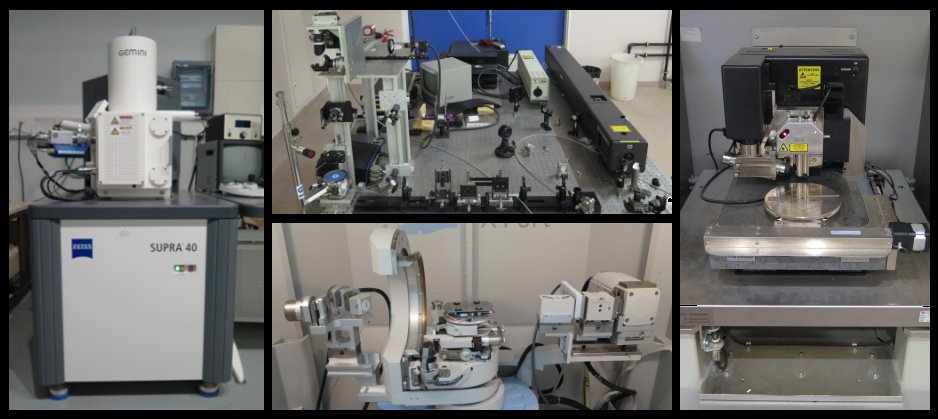The expertise center in materials characterization combines the structural characterizations and optical characterizations of CRHEA. It draws on the expertise of a researcher and five engineers of the Common Research Service around the following characterization techniques:
- scanning electron microscopy (SEM),
- transmission electron microscopy (TEM),
- atomic force microscopy (AFM),
- x-ray diffraction (XRD),
- photoluminescence (PL),
- cathodoluminescence (CL).
The expertise center in characterization, mainly serving CRHEA's research teams, also offers services to academic laboratories and companies.
Scanning electron microscopy relies on two field emission scanning electron microscopes. The first, a JEOL 7000F, can provide a high current in a small probe, which is particularly suitable for chemical analysis. It includes an AUTRATA backscattered electron detector equipped with a YAG single-crystal scintillator with high detection efficiency for chemical composition imaging. The second SEM, a ZEISS Supra 40, is equipped with a detector in the lens to obtain images with low voltage nanoscale resolution and high topographic contrast even at high magnification.
Sample preparation for transmission electron microscopy is done in the laboratory using two wire saws, two polishing machines with tripod polishing capability, two concave grinding machines, and two ionic thinners. The observations are then made by our engineer on one of the TEMs of our partners (IMRA and METSA network). The analysis of the data is carried out in the laboratory by image simulation (JEMS software) and the quantitative analysis of high resolution images by the GPA method and by methods in the direct network. CRHEA is involved in the partnership platform project for advanced characterization of materials by electron microscopy ACT-M (advanced characterization techniques for materials).
The characterization center has two Bruker atomic force microscopes. On the one hand, the Nanoscope IV Dimension 3100 images samples up to a size of 4 inches with a surface scan ranging from 0.25 µm2 to 2500 µm2, a lateral resolution of 5 nm and a vertical resolution of 0.01 nm. On the other hand, the Dimension Edge allows to study samples with a maximum size of 8 inches and has the advantage of being able to automatically manage the servo correctors via the Peak force ScanAsyst mode.
The X-ray diffraction is carried out using a 4-circle diffractometer (Panalytical X'Pert Pro MRD) operating with a copper anode, a primary optic composed of a multilayer mirror and a Ge220 monochromator, a sample holder consisting of a double tilt and XY turntable, and two secondary optical paths, in single slots or through a triple axis, each leading to a point detector. The data analysis is based on large-angle (X'pert Epitaxy, Carine) and reflectivity (Reflex12) diffraction patterns.
The characterization center has two photoluminescence benches equipped with helium-flow cryostats allowing measurements between 300K and few K. The first includes a 325 nm (50 mW) HeCd laser and a 64 cm Jobin-Yvon spectrograph. The second is composed of a Coherent Fred90C doubled 244 nm Ar laser and an Acton SP558 spectrograph. An Oxford Spectromag cryostat allows the measurement of PL under magnetic field up to 8T. UV / Vis reflectivity measurements are also possible. A device of µPL (10 K - 300 K), comprising a pulsed YAG at 266 nm and having a spatial resolution on the studied sample of the order of 3 µm is also available.
A cathodoluminescence system cooled with liquid nitrogen is in place on the JEOL 7000F microscope of the laboratory. This system is composed of a GATAN CL4 monochromator equipped with two gratings 150 and 1200tr / mm, detection via a high sensitivity photomultiplier and an UV-enhanced CCD camera.
Finally, in the infrared domain, the characterization center is equipped with a Bruker Tensor27 Fourier Transform Infrared spectrometer (FTIR).



